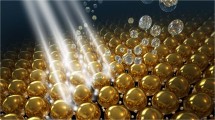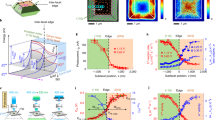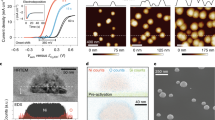Abstract
Charge transport in nanoparticle-based materials underlies many emerging energy-conversion technologies, yet assessing the impact of nanometre-scale structure on charge transport across micrometre-scale distances remains a challenge. Here we develop an approach for correlating the spatial distribution of crystalline and current-carrying domains in entire nanoparticle aggregates. We apply this approach to nanoparticle-based α-Fe2O3 electrodes that are of interest in solar-to-hydrogen energy conversion. In correlating structure and charge transport with nanometre resolution across micrometre-scale distances, we have identified the existence of champion nanoparticle aggregates that are most responsible for the high photoelectrochemical activity of the present electrodes. Indeed, when electrodes are fabricated with a high proportion of these champion nanostructures, the electrodes achieve the highest photocurrent of any metal oxide photoanode for photoelectrochemical water-splitting under 100 mW cm−2 air mass 1.5 global sunlight.
This is a preview of subscription content, access via your institution
Access options
Subscribe to this journal
Receive 12 print issues and online access
$259.00 per year
only $21.58 per issue
Buy this article
- Purchase on Springer Link
- Instant access to full article PDF
Prices may be subject to local taxes which are calculated during checkout






Similar content being viewed by others
References
Arico, A. S., Bruce, P., Scrosati, B., Tarascon, J-M. & van Schalkwijk, W. Nanostructured materials for advanced energy conversion and storage devices. Nature Mater. 4, 366–377 (2005).
Warren, S. C. et al. Ordered mesoporous materials from metal nanoparticle-block copolymer self-assembly. Science 320, 1748–1752 (2008).
Penn, R. L. & Banfield, J. F. Imperfect oriented attachment: Dislocation generation in defect-free nanocrystals. Science 281, 969–971 (1998).
Banfield, J. F., Welch, S. A., Zhang, H., Ebert, T. T. & Penn, R. L. Aggregation-based crystal growth and microstructure development in natural iron oxyhydroxide biomineralization products. Science 289, 751–754 (2000).
Zheng, H. et al. Observation of single colloidal platinum nanocrystal growth trajectories. Science 324, 1309–1312 (2009).
Li, D. et al. Direction-specific interactions control crystal growth by oriented attachment. Science 336, 1014–1018 (2012).
Ostwald, W. Lehrbuch der Allgemeinen Chemie. Vol. 2 (W. Engelmann Leipzig, 1896).
Schliehe, C. et al. Ultrathin PbS sheets by two-dimensional oriented attachment. Science 329, 550–553 (2010).
Seager, C. H. & Ginley, D. S. Passivation of grain boundaries in polycrystalline silicon. Appl. Phys. Lett. 34, 337–340 (1979).
Green, M. A., Emery, K., Hishikawa, Y., Warta, W. & Dunlop, E. D. Solar cell efficiency tables (version 39). Prog. Photovolt. 20, 12–20 (2012).
Grätzel, M. Photovoltaic and photoelectrochemical conversion of solar energy. Phil. Tran. R. Soc. A 365, 993–1005 (2007).
Dotan, H., Sivula, K., Graetzel, M., Rothschild, A. & Warren, S. C. Probing the photoelectrochemical properties of α-Fe2O3 electrodes using hydrogen peroxide (H2O2) as a hole scavenger. Energy Environ. Sci. 4, 958–964 (2011).
Kay, A., Cesar, I. & Gratzel, M. New benchmark for water photooxidation by nanostructured α-Fe2O3 films. J. Am. Chem. Soc. 128, 15714–15721 (2006).
Spray, R. L. & Choi, K-S. Photoactivity of transparent nanocrystalline Fe2O3 electrodes prepared via anodic electrodeposition. Chem. Mater. 21, 3701–3709 (2009).
Wang, H., Deutsch, T. & Turner, J. A. Direct water splitting under visible light with nanostructured hematite and WO3 photoanodes and a GaInP2 photocathode. J. Electrochem. Soc. 155, F91–F96 (2008).
Jang, J. S., Yoon, K. Y., Xiao, X., Fan, F-R. F. & Bard, A. J. Development of a potential Fe2O3-based photocatalyst thin film for water oxidation by scanning electrochemical microscopy: Effects of Ag–Fe2O3 nanocomposite and Sn doping. Chem. Mater. 21, 4803–4810 (2009).
Thimsen, E., Leformal, F., Graetzel, M. & Warren, S. C. Influence of plasmonic Au nanoparticles on the photoactivity of Fe2O3 electrodes for water splitting. Nano Lett. 11, 35–43 (2011).
Beermann, N., Vayssieres, L., Lindquist, S. E. & Hagfeldt, A. Photoelectrochemical studies of oriented nanorod thin films of hematite. J. Electrochem. Soc. 147, 2456–2461 (2000).
Kleiman-Shwarsctein, A., Hu, Y-S., Forman, A. J., Stucky, G. D. & McFarland, E. W. Electrodeposition of α-Fe2O3 doped with Mo or Cr as photoanodes for photocatalytic water splitting. J. Phys. Chem. C 112, 15900–15907 (2008).
Lin, Y., Zhou, S., Sheehan, S. W. & Wang, D. Nanonet-based hematite heteronanostructures for efficient solar water splitting. J. Am. Chem. Soc. 133, 2398–2401 (2011).
Van de Krol, R., Liang, Y. Q. & Schoonman, J. Solar hydrogen production with nanostructured metal oxides. J. Mater. Chem. 18, 2311–2320 (2008).
Warren, S. C. & Thimsen, E. Plasmonic solar water splitting. Energy Environ. Sci. 5, 5133–5146 (2012).
Dotan, H. et al. Resonant light trapping in ultrathin films for water splitting. Nature Mater. 12, 158–164 (2013).
Brillet, J. et al. Highly efficient water splitting by a dual-absorber tandem cell. Nature Photon. 6, 824–828 (2012).
Lin, Y. et al. Growth of p-type hematite by atomic layer deposition and its utilization for improved solar water splitting. J. Am. Chem. Soc. 134, 5508–5511 (2012).
Barroso, M. et al. Dynamics of photogenerated holes in surface modified α-Fe2O3 photoanodes for solar water splitting. Proc. Natl Acad. Sci. USA 109, 15640–15645 (2012).
Li, L. et al. Facile solution synthesis of α-FeF3·3H2O nanowires and their conversion to α-Fe2O3 nanowires for photoelectrochemical application. Nano Lett. 12, 724–731 (2012).
Klahr, B., Gimenez, S., Fabregat-Santiago, F., Hamann, T. & Bisquert, J. Water oxidation at hematite photoelectrodes: The role of surface states. J. Am. Chem. Soc. 134, 4294–4302 (2012).
Marusak, L. A., Messier, R. & White, W. B. Optical absorption spectrum of hematite, α-Fe2O3 near IR to UV. J. Phys. Chem. Solids 41, 981–984 (1980).
Tilley, S. D., Cornuz, M., Sivula, K. & Grätzel, M. Light-induced water splitting with hematite: Improved nanostructure and iridium oxide catalysis. Angew. Chem. Int. Ed. 49, 6405–6408 (2010).
Cornuz, M., Grätzel, M. & Sivula, K. Preferential orientation in hematite films for solar hydrogen production via water splitting. Chem. Vap. Deposition 16, 291–295 (2010).
Liu, H. H. et al. Three-dimensional orientation mapping in the transmission electron microscope. Science 332, 833–834 (2011).
Dingley, D. J. Orientation imaging microscopy for the transmission electron microscope. Microchim. Acta 155, 19–29 (2006).
Huang, P. Y. et al. Grains and grain boundaries in single-layer graphene atomic patchwork quilts. Nature 469, 389–392 (2011).
Shockley, W. & Read, W. T. Statistics of the recombinations of holes and electrons. Phys. Rev. 87, 835–842 (1952).
Pike, G. E. & Seager, C. H. The dc voltage dependence of semiconductor grain-boundary resistance. J. Appl. Phys. 50, 3414–3422 (1979).
Kennedy, J. H. & Frese, K. W. Jr Photooxidation of water at α-Fe2O3 electrodes. J. Electrochem. Soc. 125, 709–714 (1978).
Memming, R. Semiconductor Electrochemistry (Wiley VCH, 2001).
Gardner, R. F. G., Sweett, F. & Tanner, D. W. The electrical properties of alpha ferric oxide–II.: Ferric oxide of high purity. J. Phys. Chem. Solids 24, 1183–1186 (1963).
Benjelloun, D. et al. Anisotropie des proprietes electriques de l’oxyde de fer Fe2O3α. Mater. Chem. Phys. 10, 503–518 (1984).
Read, W. T. & Shockley, W. Dislocation models of crystal grain boundaries. Phys. Rev. 78, 275–289 (1950).
Blatter, G. & Greuter, F. Carrier transport through grain boundaries in semiconductors. Phys. Rev. B 33, 3952–3966 (1986).
Cesar, I., Sivula, K., Kay, A., Zboril, R. & Graetzel, M. Influence of feature size, film thickness, and silicon doping on the performance of nanostructured hematite photoanodes for solar water splitting. J. Phys. Chem. C 113, 772–782 (2009).
Mohapatra, S. K., John, S. E., Banerjee, S. & Misra, M. Water photooxidation by smooth and ultrathin α-Fe2O3 nanotube arrays. Chem. Mater. 21, 3048–3055 (2009).
Rangaraju, R. R., Panday, A., Raja, K. S. & Misra, M. Nanostructured anodic iron oxide film as photoanode for water oxidation. J. Phys. D 42, 135303 (2009).
Sanchez, C., Sieber, K. D. & Somorjai, G. A. The photochemistry of niobium doped α-Fe2O3 . J. Electroanal. Chem. 252, 269–290 (1988).
Gonçalves, R. H., Lima, B. H. R. & Leite, E. R. Magnetite colloidal nanocrystals: A facile pathway to prepare mesoporous hematite thin films for photoelectrochemical water splitting. J. Am. Chem. Soc. 133, 6012–6019 (2011).
Sivula, K. et al. Photoelectrochemical water splitting with mesoporous hematite prepared by a solution-based colloidal approach. J. Am. Chem. Soc. 132, 7436–7444 (2010).
Orton, J. W. & Powell, M. J. The Hall effect in polycrystalline and powdered semiconductors. Rep. Prog. Phys. 43, 1263–1307 (1980).
Coffey, D. C. & Ginger, D. S. Time-resolved electrostatic force microscopy of polymer solar cells. Nature Mater. 5, 735–740 (2006).
Acknowledgements
The authors acknowledge support of this research by the European Commission (Nanostructured Photoelectrodes for Energy Conversion, NanoPEC, contract number 227179) and the Swiss Federal Office for Energy (PECHouse Competence Center, contract number 152933). M.G. thanks the European Research Council (ERC) for funding part of this work under the advanced research grant (ARC) 247404 ‘Mesolight’. We thank E. Thimsen, C. Koch, T. Mason, U. Wiesner, D. Gamelin, M. Hersam and R. van de Krol for helpful discussions.
Author information
Authors and Affiliations
Contributions
S.C.W. conceived most experiments and performed the electrochemical and electron microscopy measurements. K.V. performed the C-AFM measurements, performed statistical analyses and, with F.S., analysed these results. A.R. and H.D. conceived and developed the photocurrent model. S.C.W. and C.H. analysed the DF-TEM data. C.M.L. measured the macroscopic electrical properties of electrodes. M.C. prepared electrodes. S.C.W. and M.G. analysed the electrochemical data. S.C.W. wrote most of the manuscript; K.V. wrote sections on C-AFM. All authors contributed to revisions.
Corresponding author
Ethics declarations
Competing interests
The authors declare no competing financial interests.
Supplementary information
Supplementary Information
Supplementary Information (PDF 6127 kb)
Rights and permissions
About this article
Cite this article
Warren, S., Voïtchovsky, K., Dotan, H. et al. Identifying champion nanostructures for solar water-splitting. Nature Mater 12, 842–849 (2013). https://doi.org/10.1038/nmat3684
Received:
Accepted:
Published:
Issue Date:
DOI: https://doi.org/10.1038/nmat3684
This article is cited by
-
Epitaxially grown silicon-based single-atom catalyst for visible-light-driven syngas production
Nature Communications (2023)
-
Synergistic effects of mixing and strain in high entropy spinel oxides for oxygen evolution reaction
Nature Communications (2023)
-
Inductive effect of Ti-doping in Fe2O3 enhances the photoelectrochemical water oxidation
Science China Chemistry (2023)
-
Electrochemical scanning probe microscopies for artificial photosynthesis
Nano Research (2023)
-
Recent Development of Nanostructured Nickel Metal-Based Electrocatalysts for Hydrogen Evolution Reaction: A Review
Topics in Catalysis (2023)



